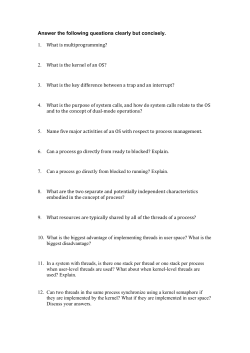
COSC450 Operating System Chapter 4 Exercise Problem Solution
COSC450 Operating System Chapter 4 Exercise Problem Solution 10. Neither change leads to deadlock. There is no circular wait in either case. 14. First, the set of unmarked processes, P = (P1 P2 P3 P4) R1 is not less than or equal to A R2 is less than A; Mark P2; A=(0 2 0 3 1); P = (P1 P3 P4) R1 is not less than or equal to A R3 is equal to A; Mark P3; A=(0 2 0 3 2); P = (P1 P4) R1 is not less than or equal to A R4 is not less than or equal to A So, processes P1 and P4 remain unmarked. They are deadlocked. 15. Recovery through preemption: After processes P2 and P3 complete, process P1 can be forced to preempt 1 unit of RS3. This will make A = (0 2 1 3 2), and allow process P4 to complete. Once P4 completes and release its resources P1 may complete. Recovery through rollback: Rollback P1 to the state checkpointed before it acquired RS3. Recovery through killing processes: Kill P1. 20. A request from D is unsafe, but one from C is safe. 21. The system is deadlock free. Suppose that each process has one resource. There is one resource free. Either process can ask for it and get it, in which case it can finish and release both resources. Consequently, deadlock is impossible. 22. If a process has m resources it can finish and cannot be involved in a deadlock. Therefore, the worst case is where every process has m − 1 resources and needs another one. If there is one resource left over, one process can finish and release all its resources, letting the rest finish too. Therefore the condition for avoiding deadlock is r ≥ p(m − 1) + 1. 23. No. D can still finish. When it finishes, it returns enough resources to allow E(or A) to finish, and so on. 24. Comparing a row in the matrix to the vector of available resources takes m operations. This step must be repeated on the order of n times to find a process that can finish and be marked as done. Thus, marking a process as done takes on the order of mn steps. Repeating the algorithm for all n processes means that the number of steps is then mn2. Thus, a = 1 and b = 2. 25. The needs matrix is as follows: 01002 02100 10300 00111 If x is 0, we have a deadlock immediately. If x is 1, process D can run to completion. When it is finished, the available vector is 1 1 2 2 1. Unfortunately we are now deadlocked. If x is 2, after D runs, the available vector is 1 1 3 2 1 and C can run. After it finishes and returns its resources the available vector is 2 2 3 3 1, which will allow B to run and complete, and then A to run and complete. Therefore, the smallest value of x that avoids a deadlock is 2. 28. Suppose that process A requests the records in the order a, b, c. If process B also asks for a first, one of them will get it and the other will block. This situation is always deadlock free since the winner can now run to completion without interference. Of the four other combinations, some may lead to deadlock and some are deadlock free. The six cases are as follows: a b c deadlock free a c b deadlock free b a c possible deadlock b c a possible deadlock c a b possible deadlock c b a possible deadlock Since four of the six may lead to deadlock, there is a 1/3 chance of avoiding a deadlock and a 2/3 chance of getting one.
© Copyright 2025




![[Full Text] - International Journal of Computer Science](http://cdn1.abcdocz.com/store/data/000756084_1-e103cbc8bd053efd0ef6a173df1182d4-250x500.png)




